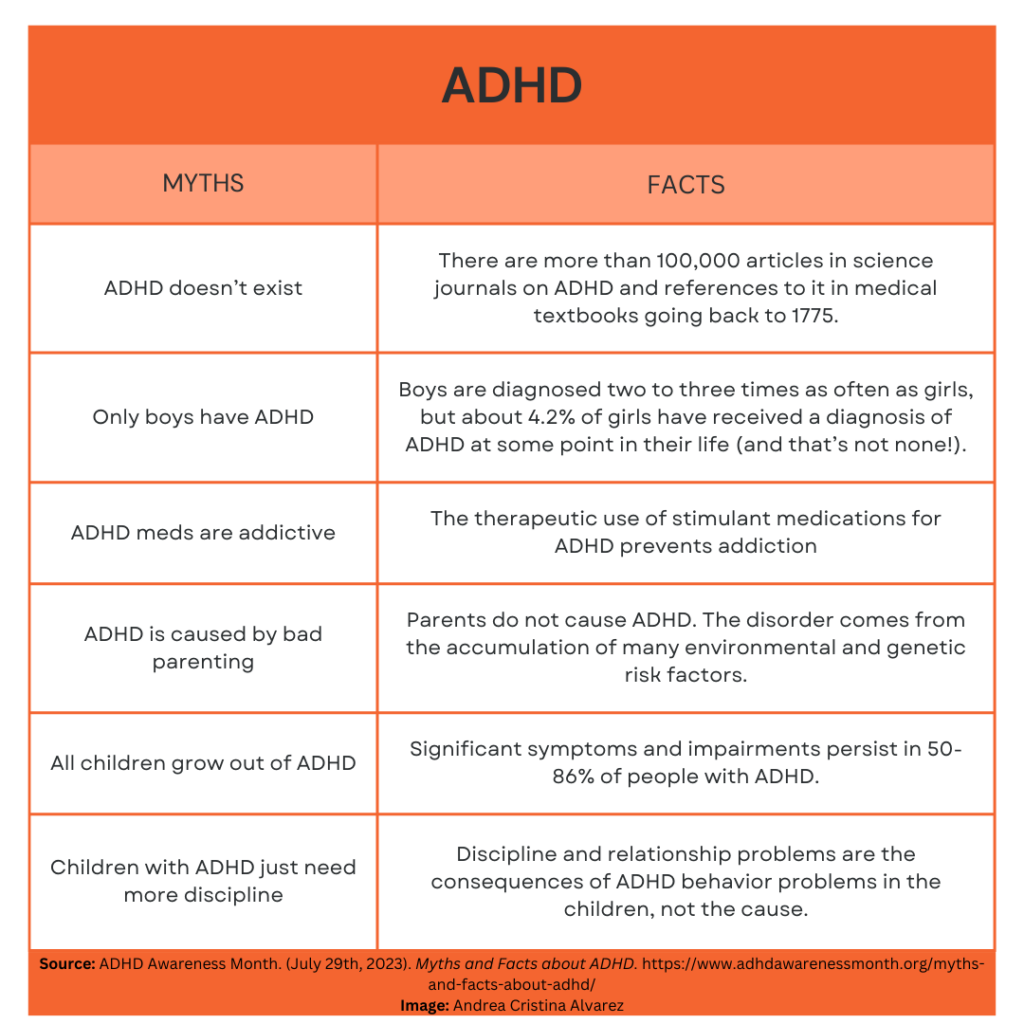The World Health Organization, in its World Mental Health Report: Transforming Mental Health for All, noted that 8.8% of the world’s population suffers from attention deficit hyperactivity disorder (ADHD), or approximately 85 million people. It is time to understand this disorder more and end prejudices about it.
What is ADHD?
Attention deficit hyperactivity disorder, better known as ADHD, is classified in the DSM-5 (the fifth edition of the Diagnostic and Statistical Manual of Mental Disorders) as a neurodevelopmental disorder.
This disorder is usually characterized by a “persistent pattern of inattention and/or hyperactivity-impulsivity” that often interferes with a person’s functioning. There are three types:
- ADHD, inattentive type: Inattention and distraction without hyperactivity predominate.
- ADHD, impulsive-hyperactive type: The least frequent, it is characterized by impulsive and hyperactive behaviors without lack of attention and distraction.
- ADHD, combined type: This most common behavior has characteristics of the other two subtypes.
Previously, it was believed that only children could suffer from this disorder; however, the most recent edition of the DSM-5 incorporates this diagnosis for both adolescents and adults.
Main Symptoms and Diagnosis
Despite being one of the most well-known and frequent neurodevelopmental disorders, we can easily overlook the symptoms. Let’s review them in the three types of ADHD:
Inattentive Type
- Not paying attention to details or making careless mistakes.
- Difficulty maintaining attention on tasks or recreational activities.
- Does not seem to listen when spoken to directly.
- Inability to follow directions and finish tasks.
- Difficulty organizing tasks and activities.
- Avoiding or showing dislike for tasks that require sustained mental effort.
- Losing necessary things.
- Easily distracted by external stimuli.
- Forgetting everyday tasks.
Impulsive-hyperactive type
- Fidgeting with hands or feet.
- Standing in situations where sitting is appropriate.
- Inappropriate running or climbing.
- Unable to play quietly.
- Acting as if “powered by an engine.”
- Talking excessively.
- Answering before the question is finished.
- Difficulty waiting for their turn.
- Interrupting others.
Combined Type
- Includes the symptoms of the previous two types.
Signs of this disorder can occur as early as infancy but prevail towards adulthood. The most effective treatment combines medications, education, skills training, and psychological counseling; these can control some ADHD symptoms but not cure them.
In addition, given the type of symptoms, people often have misconceptions about people with attention deficit and hyperactivity disorder. Thomas E. Brown, a clinical psychologist from Yale University, explains that ADHD can be confused with a lack of will or simple laziness, but this is not the case: This disorder is a problem that involves the chemical dynamics in the brain, so it is not subject to the will of those who suffer from it.
Myths and Facts about ADHD
ADHD Awareness Month shares a list of myths and facts about ADHD because misconceptions about it boil down to hurtful notions perpetuating its stigma.

Living with ADHD
People living with ADHD may face different challenges related to the disorder throughout their lives. In childhood, due to inattention, they may struggle in school and experience academic challenges. In addition, because of impulsivity, they may have problems with their peers.
On the other hand, adults will see their organization and time management affected, which can lead to problems trying to hold onto a stable job. That is why ADHD can often occur with other mental health conditions, stemming from how the disorder affects their daily lives:
- Up to 30% of children and 25 to 40% of adults live with ADHD and anxiety disorder.
- Up to 70% of people with ADHD are treated for depression at some point in their lives.
- Sleep disorders affect those with ADHD two to three times more often than those without.
On the other hand, Weill Cornell Medicine points out the differences between living with ADHD in childhood and adulthood. The disorder in childhood manifests as being disorganized, daydreaming, constantly losing things, and talking a lot. In adulthood, there are also episodes of hyperconcentration, procrastination, starting projects without finishing them, and continually struggling with deadlines.
ADHD in education
One of the essential characteristics of this disorder is the “difficulty in maintaining voluntary attention in the face of activities, both academic and daily and coupled with the lack of impulse control,” which is why one of the most affected areas is the school environment. Teachers must make the necessary curricular adjustments to formulate functional and effective student learning strategies. For this, teachers must have clear and non-biased information at their disposal.
Rocío Meca Martínez, a pedagogical specialist at the CADAH Foundation, makes specific recommendations to teachers to promote work in the classroom, especially for primary education where the symptoms may be more visible:
- Make classes more dynamic.
- Emphasize communication between families, teachers, and therapists.
- Learn about the disorder.
- Avoid depriving students of their breaks.
- Reduce tasks.
- Make accommodations that are in the student’s best interest.
In addition, the pedagogist recommends that teachers remember that learning more does not mean they are not prepared for the job but rather that they do their best to improve their educational work. Notably, many teachers consider children with ADHD to be sassy or rude, a prejudice that uninformed teachers continue to promote.
ADHD Awareness Month
Every October, many countries around the world commemorate ADHD Awareness Month. This year’s particular theme is “Moving Forward with ADHD.”
The mission of ADHD Awareness Month is to educate the public about this disorder by sharing evidence-based information. This coalition comprises ACO (ADHD Coaches Organization), ADDA (Attention Deficit Disorder Association), and CHADD (Children and Adults with Attention-Deficit/Hyperactivity Disorder). In addition, this year, the sponsors are joining forces with the Center for ADHD Awareness, Canada (CADDAC), and ADHD Europe.
Although there is increasingly more discussion about mental health, it is urgent to continue raising awareness, as we have already seen the ideas that prevail in myths versus realities. ADHD prejudices can prevent the search for an early diagnosis.
That is why one of the ways to raise awareness is to motivate the ADHD community to express themselves on social media by telling their stories through art, memes, or videos to reduce stigma, encourage early intervention, and support families who need guidance. The aim is also to raise awareness of how this condition affects people’s well-being, mental health, and social and work lives.
Importance of Early Diagnosis
Stanford Medicine highlights that measures to prevent ADHD are still unknown. Still, it advocates for early detection and intervention, which can help reduce the severity of symptoms and ensure a better quality of life in children, adolescents, and adults.
So, this implies acknowledging that in childhood, girls are diagnosed with this disorder to a lesser extent than their peers of the opposite sex, a situation that reverses in adulthood. ADHD in girls often goes unnoticed until much later because symptoms tend to be more inattentive than hyperactive.
If you or someone you know has ADHD, share your experience in the comments and help us break the stigma.
Translated by Daniel Wetta
This article from Observatory of the Institute for the Future of Education may be shared under the terms of the license CC BY-NC-SA 4.0 
)
)


)